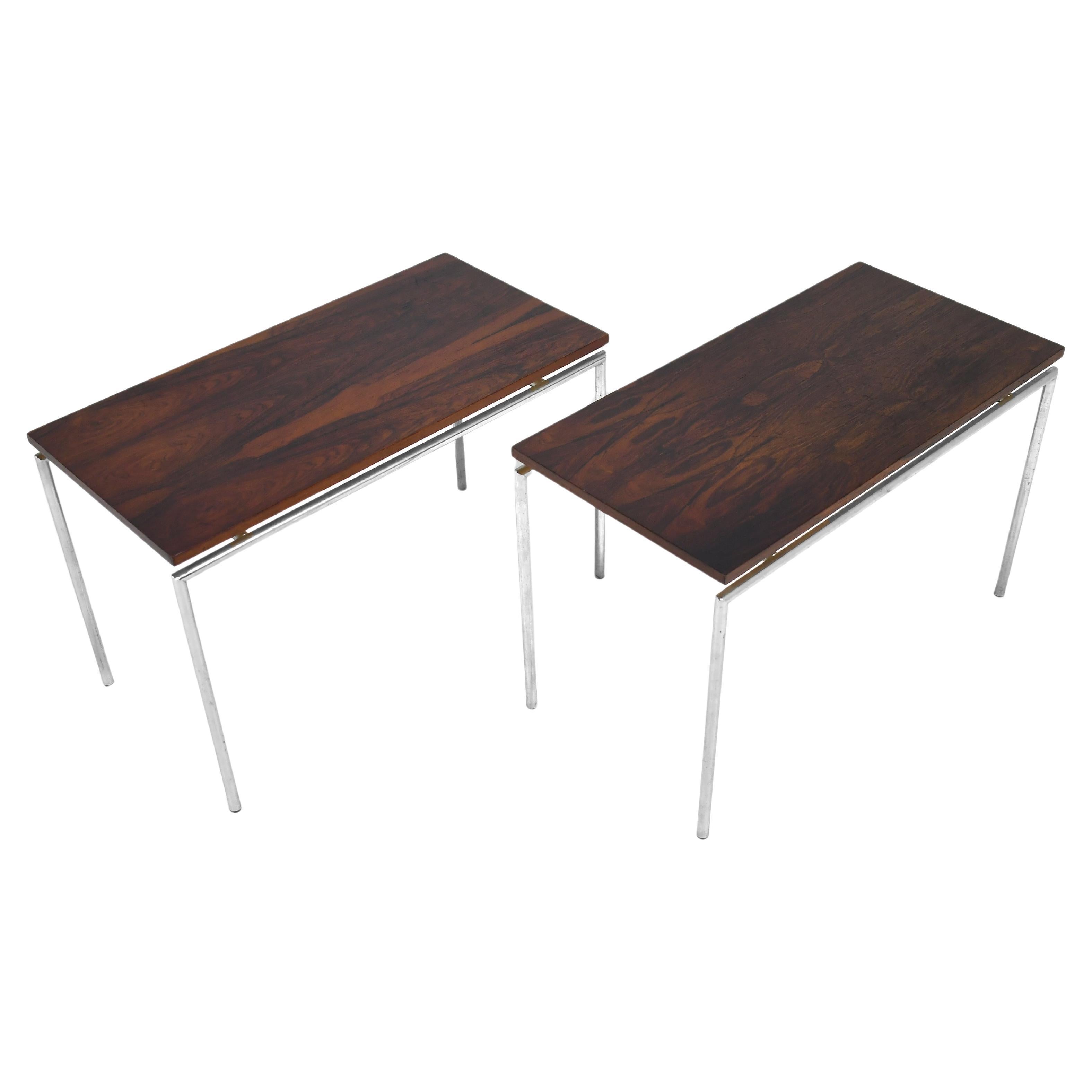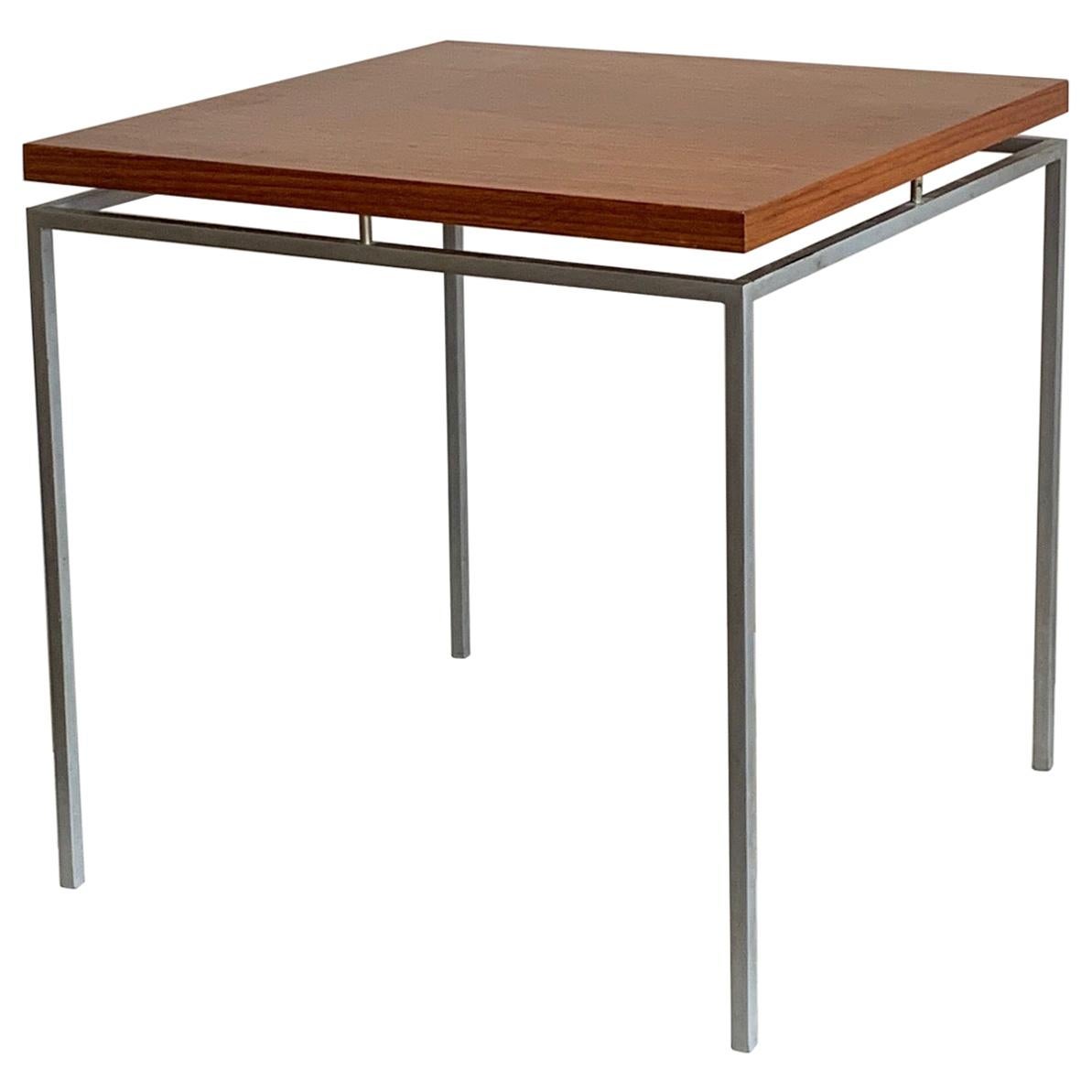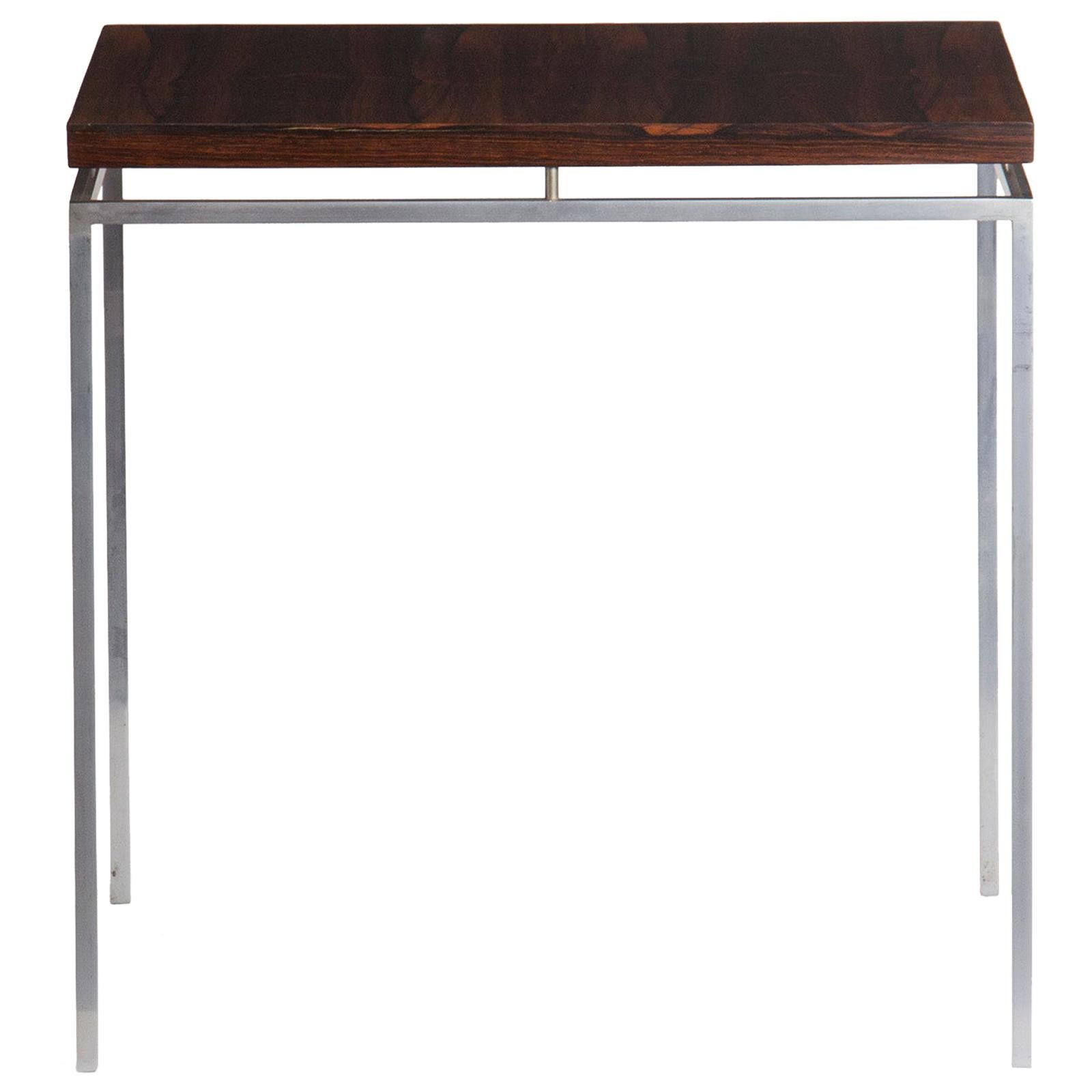Items Similar to Knud Joos Rosewood Side Table
Video Loading
Want more images or videos?
Request additional images or videos from the seller
1 of 7
Knud Joos Rosewood Side Table
About the Item
Knud Joos Rosewood Side Table with beautiful steal frame.
Dimensions: 16.5 L x 16.5 W x 16.25H
About the Designer:
Knud Joos was a Danish furniture designer and craftsman known for his contributions to mid-century modern design. He was born in 1919 and passed away in 2004. Joos was a prominent figure in the Danish design scene during the mid-20th century, a period that saw a flourishing of Scandinavian design internationally.
Joos' work was characterized by clean lines, simplicity, and functionality, all hallmarks of Scandinavian design principles. He often worked with wood, particularly teak and rosewood, which were popular materials among Danish designers of his era.
While not as widely recognized as some other Danish designers such as Hans Wegner or Arne Jacobsen, Knud Joos made significant contributions to the field, creating furniture pieces that reflected the ethos of modernism and the Danish design tradition. His designs were known for their timeless appeal and quality craftsmanship, and they continue to be sought after by collectors and enthusiasts of mid-century modern furniture.
- Creator:Knud Joos (Designer)
- Dimensions:Height: 16.25 in (41.28 cm)Width: 16.5 in (41.91 cm)Depth: 16.5 in (41.91 cm)
- Style:Mid-Century Modern (Of the Period)
- Materials and Techniques:
- Place of Origin:
- Period:
- Date of Manufacture:unknown
- Condition:Refinished.
- Seller Location:San Diego, CA
- Reference Number:1stDibs: LU6417239511892
About the Seller
5.0
Vetted Seller
These experienced sellers undergo a comprehensive evaluation by our team of in-house experts.
Established in 2020
1stDibs seller since 2022
44 sales on 1stDibs
Typical response time: 1 hour
- ShippingRetrieving quote...Ships From: San Diego, CA
- Return PolicyA return for this item may be initiated within 1 day of delivery.
More From This SellerView All
- Peter Løvig Nielsen Small Side TableBy Peter Løvig NielsenLocated in San Diego, CAAs architecturally fascinating as it is aesthetically pleasing, this iconic table, designed by Peter Løvig Nielsen in the early 60's. Featuring turned edges built of solid teak with ...Category
Vintage 1960s Danish Mid-Century Modern Side Tables
MaterialsTeak
- Pair of Amoeba Side Tables by Erno FabryBy Erno FabryLocated in San Diego, CAIntroducing the epitome of charm and functionality: Erno Fabry's exquisite pair of side tables. Crafted with precision and passion, these side tables are not just furniture pieces bu...Category
Vintage 1950s American Mid-Century Modern Side Tables
MaterialsWalnut, Glass
- A Danish Modern Console/ Dresser in RosewoodLocated in San Diego, CABeautiful Rosewood Chest of Console with A Frame Cantilevered Legs. The Maker or designer is unknown. Very good danish quality overall. 28.75" W x 15.25" D x 26.75" HCategory
20th Century Danish Mid-Century Modern Console Tables
MaterialsRosewood
- Rosewood Desk by Torbjorn Afdal for BruksboBy Bruksbo, Torbjørn AfdalLocated in San Diego, CARare hand-crafted rosewood desk designed by Torbjorn Afdal for Bruksbo. The drawers made with very fine detailed zipper joinery. With original key and working lock mechanism. Origina...Category
Vintage 1950s Norwegian Mid-Century Modern Desks and Writing Tables
MaterialsRosewood
- George Nelson Rosewood Thin Edge 4 drawer Dresser by Herman Miller #2By George NelsonLocated in San Diego, CAA rosewood thin edge chest designed by George Nelson for Herman Miller with exquisite rosewood grain and early original white porcelain handles. The George Nelson Rosewood Thin Edge 4-drawer Dresser, crafted by Herman Miller, epitomizes the timeless elegance and functional sophistication synonymous with mid-century modern design. This dresser stands as an iconic piece within the George Nelson collection, renowned for its clean lines, minimalist aesthetic, and impeccable craftsmanship. This particular example boasts exquisite rosewood grain and early original white porcelain handles. Constructed from rich rosewood veneer, the dresser boasts a warm, organic hue that exudes luxury and refinement. Its slender profile and thin edges create an illusion of lightness, enhancing the overall sense of modernity and grace. The 4 spacious drawers feature seamless integration of hardware, maintaining the dresser's sleek appearance while providing ample storage space for clothing, linens, or personal belongings. Each detail of the George Nelson Rosewood Thin Edge series reflects an unwavering commitment to both form and function. Its timeless design transcends trends, making it a versatile addition to any interior decor scheme, from minamalist to post-modern. Whether used in a bedroom, living area, or office space, this dresser elevates the ambiance with its understated elegance and unparalleled craftsmanship, showcasing the enduring legacy of George Nelson's visionary design ethos. About the Designer: Not everyone thinks of George Nelson when they think “Modernism”—but they should. Here’s why: Looking at the outset of George Nelson’s career, few would have guessed that his legacy would crown him as one of the most influential individuals in Modernism—story has it that the young Ivy Leaguer stumbled into the Yale School of Architecture seeking shelter from the rain, and only then did he consider studying design. His legacy, though, would be one that touched nearly every corner of American Modernism as we think of it today. As an architect, author, furniture designer, graphic designer, exhibition designer, teacher, amateur photographer, and general provocateur, George Nelson shaped the course of design in America for over four decades. After completing his two Bachelor’s degrees (one in architecture, the other in fine arts), Nelson went on to accept a traveling fellowship in Rome, which interfaced him with figures like Ludwig Mies Van Der Rohe, Walter Gropius, Le Corbusier, and Gio Ponti all of which he interviewed forPencil Point, bringing the European vanguard to the attention of the magazine’s American readership. At this point in his career, Nelson had devoted himself to writing, joining Architectural Forum as its first associate editor in 1935. For nearly a decade, Nelson’s post as an editor brought him face-to-face with many of the leaders of the Modernism movement in the U.S., and through these exchanges, his own stance in the design world began to solidify. For Nelson, the purpose of design was to improve the world in accordance with the laws of nature—and while he hadn’t yet done much designing himself, he was busy teasing out the theoretical details of architecture. In 1940, Nelson co-authored Tomorrow’s House with Henry Wright, and the book went on to be a great commercial success, introducing concepts like the “family room,” and more broadly assuming a solutions-based perspective for architectural design. It wasn’t long before the book earned him the favorable attention of D.J. Depree, the chairman of Herman Miller the American furniture manufacture. Despite Nelson’s inexperience in furniture design, Depree saw potential in the writer’s approach to the industry: solutions-oriented design with a practical lean. Nelson became the company’s Director of Design in 1947, under the condition that he be allowed to continue his work outside of the company. From 1947 to 1972, Nelson oversaw the design department at Herman Miller, bringing in the icons that would shape some of the most memorable pieces of mid-century design, from such people as Ray and Charles Eames and Harry Bertoia to Richard Schultz, Donald Knorr, and Isamu Noguchi. Beginning in the mid-1950s, Nelson’s own design firm began its work in earnest, producing furniture and pioneering a ubiquitous incorporation of design, bringing that same consideration for pragmatism and aesthetics to advertising and marketing materials, image management, and graphic programs. His own firm incorporated in 1955, tapping many of the same designers from the Herman Miller roster for collaborations under George Nelson Associates, Inc. It was during this period of Nelson’s life and career that many of his most iconic designs came onto the scene—many will be instantly familiar furniture silhouettes that perhaps you didn’t know sprung from George Nelson himself. Designing his first collection in 1945 and appointed design director in 1947, Nelson quickly expanded his purview and transformed the company. Confirming De Pree’s early assessment of Nelson as someone “thinking well ahead of the parade,” he redesigned everything from Herman Miller’s product line to its graphics and marketing and advertising materials. Over the course of his long association with Herman Miller, Nelson designed hundreds of pieces of furniture and recruited other designers, including Charles and Ray Eames, Alexander Girard, and Isamu Noguchi, now all widely acknowledged as some of the brightest talents of the time. Nelson developed his own designs—from furniture to architecture, and exhibitions to graphics—in his New York City studio, known variously over the years as George Nelson, George Nelson & Associates, and George Nelson and Company. The staff included significant designers in their own right such as Irving Harper, George Mulhauser, Ernest Farmer, Gordon Chadwick, George Tscherny...Category
Vintage 1950s American Mid-Century Modern Dressers
MaterialsAluminum
- George Nelson Rosewood Thin Edge 4 drawer Dresser by Herman Miller #1By George NelsonLocated in San Diego, CAA rosewood thin edge chest designed by George Nelson for Herman Miller with exquisite rosewood grain and early original white porcelain handles. The George Nelson Rosewood Thin Edge 4-drawer Dresser, crafted by Herman Miller, epitomizes the timeless elegance and functional sophistication synonymous with mid-century modern design. This dresser stands as an iconic piece within the George Nelson collection, renowned for its clean lines, minimalist aesthetic, and impeccable craftsmanship. This particular example boasts exquisite rosewood grain and early original white porcelain handles. Constructed from rich rosewood veneer, the dresser boasts a warm, organic hue that exudes luxury and refinement. Its slender profile and thin edges create an illusion of lightness, enhancing the overall sense of modernity and grace. The 4 spacious drawers feature seamless integration of hardware, maintaining the dresser's sleek appearance while providing ample storage space for clothing, linens, or personal belongings. Each detail of the George Nelson Rosewood Thin Edge series reflects an unwavering commitment to both form and function. Its timeless design transcends trends, making it a versatile addition to any interior decor scheme, from minamalist to post-modern. Whether used in a bedroom, living area, or office space, this dresser elevates the ambiance with its understated elegance and unparalleled craftsmanship, showcasing the enduring legacy of George Nelson's visionary design ethos. About the Designer: Not everyone thinks of George Nelson when they think “Modernism”—but they should. Here’s why: Looking at the outset of George Nelson’s career, few would have guessed that his legacy would crown him as one of the most influential individuals in Modernism—story has it that the young Ivy Leaguer stumbled into the Yale School of Architecture seeking shelter from the rain, and only then did he consider studying design. His legacy, though, would be one that touched nearly every corner of American Modernism as we think of it today. As an architect, author, furniture designer, graphic designer, exhibition designer, teacher, amateur photographer, and general provocateur, George Nelson shaped the course of design in America for over four decades. After completing his two Bachelor’s degrees (one in architecture, the other in fine arts), Nelson went on to accept a traveling fellowship in Rome, which interfaced him with figures like Ludwig Mies Van Der Rohe, Walter Gropius, Le Corbusier, and Gio Ponti all of which he interviewed forPencil Point, bringing the European vanguard to the attention of the magazine’s American readership. At this point in his career, Nelson had devoted himself to writing, joining Architectural Forum as its first associate editor in 1935. For nearly a decade, Nelson’s post as an editor brought him face-to-face with many of the leaders of the Modernism movement in the U.S., and through these exchanges, his own stance in the design world began to solidify. For Nelson, the purpose of design was to improve the world in accordance with the laws of nature—and while he hadn’t yet done much designing himself, he was busy teasing out the theoretical details of architecture. In 1940, Nelson co-authored Tomorrow’s House with Henry Wright, and the book went on to be a great commercial success, introducing concepts like the “family room,” and more broadly assuming a solutions-based perspective for architectural design. It wasn’t long before the book earned him the favorable attention of D.J. Depree, the chairman of Herman Miller the American furniture manufacture. Despite Nelson’s inexperience in furniture design, Depree saw potential in the writer’s approach to the industry: solutions-oriented design with a practical lean. Nelson became the company’s Director of Design in 1947, under the condition that he be allowed to continue his work outside of the company. From 1947 to 1972, Nelson oversaw the design department at Herman Miller, bringing in the icons that would shape some of the most memorable pieces of mid-century design, from such people as Ray and Charles Eames and Harry Bertoia to Richard Schultz, Donald Knorr, and Isamu Noguchi. Beginning in the mid-1950s, Nelson’s own design firm began its work in earnest, producing furniture and pioneering a ubiquitous incorporation of design, bringing that same consideration for pragmatism and aesthetics to advertising and marketing materials, image management, and graphic programs. His own firm incorporated in 1955, tapping many of the same designers from the Herman Miller roster for collaborations under George Nelson Associates, Inc. It was during this period of Nelson’s life and career that many of his most iconic designs came onto the scene—many will be instantly familiar furniture silhouettes that perhaps you didn’t know sprung from George Nelson himself. Designing his first collection in 1945 and appointed design director in 1947, Nelson quickly expanded his purview and transformed the company. Confirming De Pree’s early assessment of Nelson as someone “thinking well ahead of the parade,” he redesigned everything from Herman Miller’s product line to its graphics and marketing and advertising materials. Over the course of his long association with Herman Miller, Nelson designed hundreds of pieces of furniture and recruited other designers, including Charles and Ray Eames, Alexander Girard, and Isamu Noguchi, now all widely acknowledged as some of the brightest talents of the time. Nelson developed his own designs—from furniture to architecture, and exhibitions to graphics—in his New York City studio, known variously over the years as George Nelson, George Nelson & Associates, and George Nelson and Company. The staff included significant designers in their own right such as Irving Harper, George Mulhauser, Ernest Farmer, Gordon Chadwick, George Tscherny...Category
Vintage 1950s American Mid-Century Modern Dressers
MaterialsAluminum
You May Also Like
- Pair of Knud Joos Rosewood Tables by Jason MoblerLocated in Highland, INThis understated and sleek pair of side tables by Knud Joos for Jason Mobler subscribe to the minimalist strain of Danish modern as practiced by Poul Kjaerholm. The slim tops of rich...Category
Vintage 1960s Danish Scandinavian Modern Side Tables
MaterialsSteel
- Classic Knud Joos Side Tables Jason Mobler Denmark 1960'sLocated in St.Petersburg, FLA pair of minimalist side/pedestal tables designed by Knud Joos for Jason Mobler, Denmark, ca' 1960's. Floating rosewood tops on steel bases. Great as side tables, display, pedestals...Category
Vintage 1960s Danish Mid-Century Modern Side Tables
MaterialsStainless Steel
- A Minimalist Danish Table By Knud JoosLocated in St.Petersburg, FLA classic Knud Joos occasional table in steel and teak for Jason Mobler, model 600. Priced individually at $1,500. Classic Minimalist design. Three available.Category
Vintage 1960s Danish Mid-Century Modern End Tables
MaterialsTeak
- Pair of Midcentury Side Tables in Rosewood by Knud Joos, Danish Design, 1960sBy Jason MøblerLocated in Lejre, DKPair of side tables in rosewood designed by Knud Joos and made by Jason Furniture Denmark, great original condition.Category
Vintage 1960s Danish Scandinavian Modern Side Tables
MaterialsRosewood
- 1960s Danish Side Tables by Knud Joos for Jason MoblerLocated in Sagaponack, NYA pair of side tables with a rosewood veneer top floating on a steel base, labeled 'Illums Bolighus, Kobenhavn'.Category
Vintage 1960s Danish Scandinavian Modern Side Tables
MaterialsSteel
- Scandinavian Modern Rosewood & Chrome End Table by Knud Joos for Jason MoblerLocated in Topeka, KSSleek vintage Scandinavian Modern solid rosewood & chrome minimalist end table with floating top by Knud Joos for Jason Mobler. Beautiful condition, keeping in mind that this is vintage and not new so will have signs of use and wear. The aluminum spacers which float the top have a bit of patina. A couple of marks on the top. Please see photos and zoom in for details. We attempt to portray any imperfections. Circa, 1960’s. This end table is much like “that little black dress,” it just works!!! Simple, classic, and timeless!! This is a GORGEOUS rosewood square occasional or end table by Knud Joos for Jason Mobler. Just take another look at the FABULOUS woodgrain on the SOLID rosewood tabletop!! It is stamped under the tabletop however… the black ink stamp has faded and is barely noticeable. The frame is comprised of straight 3/8 inch slightly brushed chrome solid steel square legs and four anodized aluminum cylindrical supports float the top. Its minimalist design is sleek, sophisticated, and absolutely STUNNING!! The quintessential Scandinavian Modern style is sure to be a focal point in any room of your home. Place this beauty next to a wonderful lounge chair as a perfect spot to set your beverage (under a coaster of course!!!) It would also be a lovely place to display foliage or a spectacular table lamp. This little Danish darling is extremely stylish and very versatile!! Knud Joos was born in 1928 and passed away in 2008. He was a creative Danish architect and designer best known for his minimalist table designs and was part of Vilhelm Wohlert’s studio, the architect behind Denmark’s most famous museum, the Louisiana Museum of Modern Art. Jason Mobler is a Danish furniture maker and editor founded in Denmark in the early 1950’s. Today, Mobler mainly concentrates on furniture by famed designers Steen Ostergaard, Jarl Heger...Category
Mid-20th Century Danish Scandinavian Modern Side Tables
MaterialsAluminum, Steel, Chrome
Recently Viewed
View AllMore Ways To Browse
Rosewood Figure
Hans Wegner Rosewood
Rosewood Table Arne
Arne Jacobsen Rosewood
Jacobsen Rosewood
Vintage Craftsman Saws
Wegner Table Steel
Jacobsen Rosewood Table
Arne Jacobsen Rosewood Table
Denmark Teak Figure
Hans Wegner Rosewood Table
Craftsman Used Table Saw
Craftsman Vintage Table Saw
Joos Knud
Antique Victorian Bamboo Table
Black Side Table Jansen
Bone Inlay Side Tables
Burr Walnut End Tables





